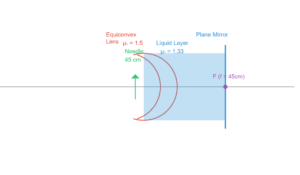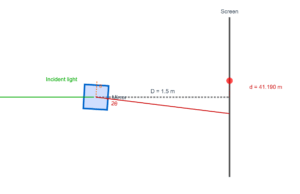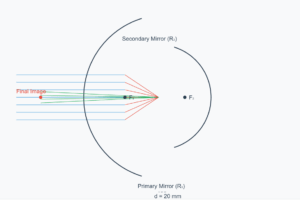Total Internal Reflection in Prism
Interactive demonstration of critical angle conditions and TIR physics in optical prisms
Ray Control
Real-time Physics Calculations
Snell's Law Applications:
Physics Insights
Total Internal Reflection
Critical Angle θc = 41.0°
When light traveling from denser medium (prism, μ=1.524) to rarer medium (air, μ=1) hits the interface at an angle greater than or equal to the critical angle, total internal reflection occurs.
Prism Geometry Constraint
A = r₁ + r₂ = 60°
In a prism, the sum of refraction angles at both faces equals the apex angle. This geometric constraint determines the ray path through the prism.
Sequential Snell's Law
First Face: n₁sin(i₁) = n₂sin(r₁)
Second Face: n₂sin(r₂) ≥ n₁sin(90°)
The critical condition occurs when the ray just reaches the critical angle at the exit face.
Textbook Problem Solution
Current Status: Ray undergoes total internal reflection at the second face. The incident angle of 29.75° creates the exact condition for TIR at the exit face.
Step-by-Step Solution
Step 1: Find Critical Angle
Given: μ = 1.524, air = 1.0
Critical Angle: sin(θc) = 1/1.524 = 0.6562
Result: θc = 41.0°
Step 2: Apply Prism Geometry
Constraint: A = r₁ + r₂ = 60°
For TIR: r₂ = 41° (critical angle)
Therefore: r₁ = 60° - 41° = 19°
Step 3: First Face Snell's Law
Apply: sin(i₁) = μ × sin(r₁)
Calculate: sin(i₁) = 1.524 × sin(19°)
Result: i₁ = 29.75°
Verification
Check: All conditions satisfied
Geometry: ✓ A = r₁ + r₂
TIR: ✓ r₂ = θc
Answer: i₁ = 29.75° for just TIR
Applications of Total Internal Reflection
Optical Fibers
Light signals travel through fiber optic cables using TIR to prevent signal loss, enabling high-speed internet and telecommunications.
Prism-based Instruments
Binoculars, periscopes, and total internal reflection microscopes use prisms to redirect light paths efficiently.
Diamond Brilliance
The high refractive index of diamond (n≈2.4) creates multiple internal reflections, giving diamonds their characteristic sparkle.
Refractometry
Critical angle measurements are used to determine refractive indices of unknown substances in analytical chemistry.



